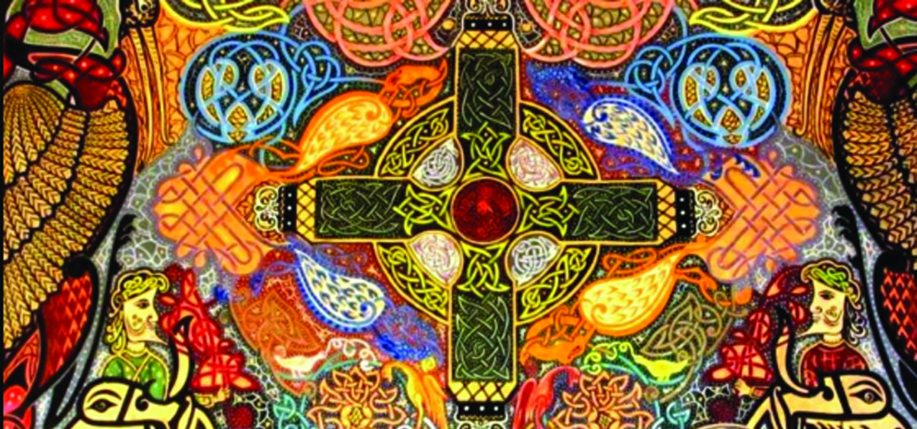A tiny chapel, just outside of Dublin City Centre in the pleasant seaside town of Dún Laoghaire, houses a stunning jewel of Celtic. Revival decoration, yet the small building is so unobtrusive that even many native Dubliners have no idea of its existence. Hidden behind the town’s Bloomsfield Shopping Center, the Oratory of the Sacred Heart is a veritable three-dimensional Book of Kells sprung to life and an enduring testament to the faith, passion, and prodigious talent of its creator, Sr. Concepta “Lily” Lynch. Born in Dublin in 1874, Lily spent most of her time in her father’s studio learning his celebrated calligraphic methods of Celtic illumination called the “Lynch Method.” Lily’s mother died when she was just six and her father died in 1887, orphaning her when she was only 16. She inherited the business from her father and ran the studio successfully until fire destroyed the shop when Lily was just 22 years old. Lily decided to join the Dominican order, taking the name Sister Concepta.
Sr. Concepta began to teach art, embroidery, and music at St. Mary’s convent school. On Saturdays, she taught the Lynch method to local children using large charts she designed, which today are preserved as graphic treasures in the archives of the National Gallery of Ireland. In addition to her artistic talents, Lynch also wrote hymns in honor of St. Thérèse of Lisieux, to whom she was devoted.

Sr. Concepta’s life changed in 1919 at the end of the First World War. Many Dún Laoghaire young men had died serving in the British Army in Northern France and the French sought to honor the sacrifice of the young men by donating a statue of the sacred heart to the local Christian Brothers School the young men had attended, but in the wake of the Irish struggle for independence, the school did not want to highlight the fact that many of its former students had fought for the British. The convent school finally took the statue and placed it in a recently constructed oratory, and asked Sr. Concepta to decorate the altar behind the statue. The convent’s mother superior was so awed by her work that she asked Sr. Concepta to decorate the entire oratory. Lynch transformed the bare, austere oratory walls with a profusion of Celtic colors, shapes, and designs. Some motifs she copied from ancient manuscripts, others were of her own invention and were strikingly original. Etienne Rynne wrote: “her work is ever mouvementé, vibrant with life; her birds squawk, bite and even dance, her serpents wriggle and knot themselves, as do her quadrupeds.” Sr. Concepta was a part of an enclosed order, which meant she could not even leave the grounds of the convent to purchase paint and other materials for the decoration. Amazingly, she had to rely on students whose families donated ordinary house paints for the project. The oratory also received stained-glass windows from the foremost Irish stained-glass glazier, Harry Clarke, who worked under Sr. Concepta’s direction. For 16 years, Sr. Concepta labored on her masterpiece, painting after teaching a full load of classes. She created stencils for the designs, which included interlacing designs, animal motifs, and a high cross, and then applied the stencils to walls. In 1936, arthritis forced her to stop work, leaving the ceiling and part of a wall undone. Three years later she died and was buried in the convent cemetery. The Dominican Convent was sold in the 1990’s and razed to make way for a new shopping center, and the oratory almost suffered the same fate, but thanks to a tenacious group of preservationists led by current Irish president Michael D. Higgins, who at the time was Minister for Arts, Culture and the Gaeltacht, the oratory was saved for posterity. Later, the decorations were restored with E.U. funding and a new building now encases and protects it.
The oratory is still not open year-round, and the tiny size of the chapel means that no more than 15 people can visit it at a time in the summer, when it is only open twice weekly. This year will mark the hundredth anniversary of Sr. Concepta’s starting to decorate the oratory, and Dún Laoghaoire plans a number of events to celebrate this amazing artistic achievement.
– Geoffrey Cobb ♦


Leave a Reply